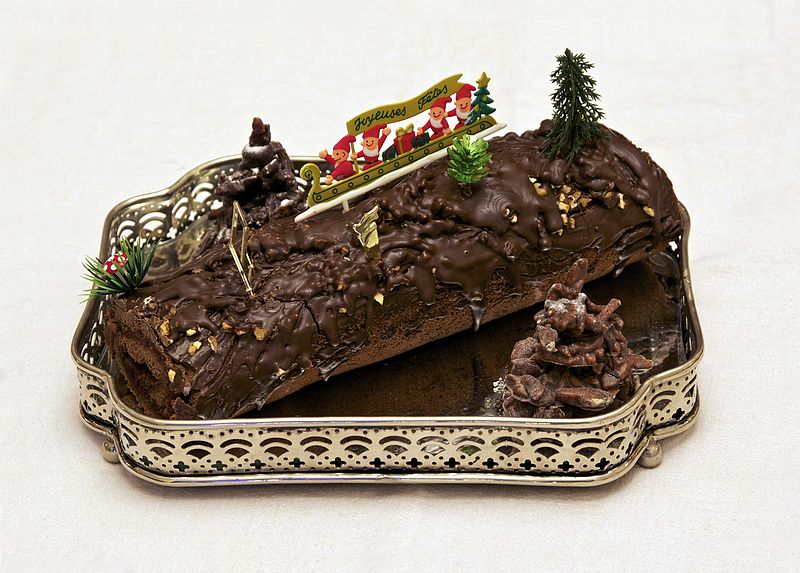The Christmas tradition of lighting the Yule Log is seldom observed in our postmodern culture of heat pumps and gas log fireplaces. Indeed, the pecan log, jelly roll, or a chocolate-filled sponge cake log have replaced the traditional long-burning Yule log when or if the tradition is even thought of as being necessary. Nevertheless, the old custom of lighting and burning the Yule Log bears examination because it is fraught with ritual and meaning that is still relevant.
The custom originated with the pagan Norsemen who brought the Yule Log south to France during their invasions, and it eventually came to England via the Normans in 1066. Both the Scandinavian Norse and their Christian descendants believed the Yule Log brought luck—the Norse believed it honored Thor, the Yule (Sun) Father, and used the log in celebration of the Winter Solstice, and the Norman Christians burned the log on Christmas Eve. Even earlier, Pope Julius the I had decreed that the ritual burning of the Yule Log would symbolize the light of the Savior (Son) rather than the Sun, and ultimately, the seasonal burning took place as far south as Greece, as far west as Ireland, and as far north as Siberia.

It is considered bad luck for the Yule Log to be purchased. Instead, it should be cut from one’s own land or the land of a neighbor. In former times, the large log was dragged through the streets to the home, which in feudal times was the manor house, and all the people of the town would be invited to the Yuletide party. By custom, it is always lit by a person with clean hands using a scrap of wood from the previous year’s log (kept for luck and to protect the house from lightening, fire, hail, and theft throughout the year), and then guests are invited to drop sprigs of holly onto the burning fire to burn up mistakes, faults, and poor choices from the previous year and thus start the new year with a clean slate.
Guests typically celebrate the lighting of the Yule Log with food and drink – a feast that includes gingerbread men (which traditionally symbolized Christ), cakes and pastries, and hot cider or wassail. Then they sing and dance or tell ghost stories and tales from the past. If the Yule Log casts a headless shadow on the wall, our ancestors would have taken it for a sign that the person whose shadow appeared would die during the next year.
Traditionally, it is considered bad luck for the Yule fire to go out before the Christmas Eve night is over as this is an omen that tragedy will strike the family. (In England in the nineteenth century, it was expected to burn the entire twelve days of Christmas, lasting until Epiphany.) In Appalachia, the celebration of family and friends lasts as long as the Yule Log burns. When it goes out, the party’s over.
Whether your faith tradition sees the Yule Log as an honoring of the earth and her cycles, a prayer for the fertility of the land and an end of hunger, a symbol of the light of Christ in each of our hearts, or the holy act of opening our homes and hearts to friends and family in celebration of the season, it is our hope that you will create your own version of the ritual of the Yule Log.
Creating Your Own Yule Log Ritual
To keep the tradition of the Yule Log in the postmodern world, you’ll need a long burning candle. You can often find these in the supermarket or in gift and specialty shops. Some burn up to seven days. It is best if someone gives it to you since traditionally, the Yule Log was not to be purchased. Maybe you and a friend can buy one for each other. I use mine as the center candle of my Advent wreath and light it at midnight on Christmas Eve, saying a prayer for peace on earth as I do.
I particularly like the idea of burning the year’s mistake. Since my fire is candle sized, I write all my regrets on a single paper and then light the paper and burn it in an ashtray or abalone shell. I’ve also burned them outside in a fireproof container so that the smoke doesn’t set off the fire detector alarm. Just remember to wash your hands and use the flame from your Yule candle to light the fire. What a symbolic way to let go of old pain and attitudes and welcome in the possibilities of the new year’s energies.
Now that I’m retiring at the end of February, I’m releasing grief; I’m going to miss the people with whom I’ve developed both working and personal friendships during the last sixteen years. I want to hold onto the memories while releasing of the sadness I feel at losing those regular connections.

Finally, share the ritual burning of the candle with friends and loved ones. Tell stories and make new memories. Have a cup of wassail and maybe even eat a slice of bûche de noel, the traditional French version of the Yule Log. Most of all, give yourself a special gift and enjoy the celebration for what it is in the moment.
Have a Joyful Holy-day.

